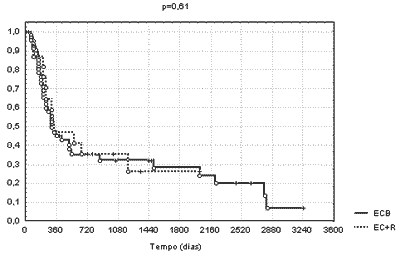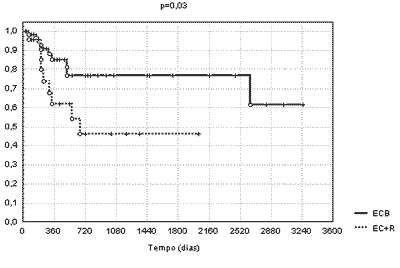INTRODUCTIONFew studies have individually assessed the patients submitted to bilateral neck dissection, since most authors consider each neck side separately, being recorded twice for patients submitted to neck dissection. Elective neck treatment conducted when the risk of occult metastases exceeds 20% is a well-defined management approach 1, 2. The rationale for elective treatment lies in the poor prognosis related to the development of untreated neck metastases, being that in neck areas are irressectable when the diagnosis is made. The same reasoning applies to treatment on the contralateral side of the neck when unilateral dissection is made. Lymphatic drainage and distribution of tumor metastases of upper aerodigestive tract have been well defined, but the likelihood of bilateral or contralateral occult metastases in a specific tumor still raises some doubts. The performance of modified and selective neck dissections, with fewer complications and sequels, allows expansion of elective indication of contralateral dissection. The present study assessed the results of the treatment of neck metastases in a single stage or in two stages among patients that developed bilateral neck disease.
MATERIAL AND METHODThe study consisted of the review of 855 medical charts of patients with squamous cell carcinoma of the mouth, oropharynx, hypopharynx and larynx submitted to primary tumor resection and radical neck dissection, including modified neck dissections types I, II and III. We excluded patients that had multiple simultaneous primary tumors or those in which the initial surgery had been aborted because of irressectability. Among the patients submitted to bilateral dissection, we included 73 patients that presented bilateral metastases confirmed histologically (ECB). Among patients submitted to unilateral dissection, we included 23 cases of histologically confirmed metastases, who later developed neck recurrence in the contralateral side (EC+R). All 96 patients were treated at the Department of Head and Neck Surgery and Otorhinolaryngology, Hospital Heliópolis, between October 1977 and December 1996. Radiotherapy was employed postoperatively in 58 cases and in the treatment of recurrences in 12 additional cases. The mean follow-up was 21 months, being that 79% of the patients had been followed up for more than 12 months. The characteristics of each group are shown in Table 1.
The progression of patients was assessed by disease free survival and neck control, calculated by Kaplan-Meier actuarial method. Patients that developed recurrence were considered asymptomatic if successfully salvaged. The differences detected were analyzed using log-rank test.
RESULTSAmong the 23 patients submitted to unilateral dissection with histology metastases (pN+) and that developed contralateral recurrence, 3 presented recurrence also in the primary site. We salvaged only 18 patients, 17 with surgery/radiotherapy and 1 exclusively with radiotherapy, in the dose of 58Gy. Among the 17 patients submitted to salvage surgery, there were 3 deaths related to the procedures. The neck control of the disease within 2 years was reached in 46% of the patients.
Among the 73 patients submitted to bilateral neck dissection (pN2c), 12 cases had neck recurrence, in which 2 were associated with primary site recurrence. Only 3 patients were salvaged, 2 with surgery/radiotherapy and 1 exclusively with radiotherapy (dose not informed). There were 7 deaths related to the initial procedure. Neck disease control within 2 years was reached in 77% of the patients.
Disease free survival was similar in the 2 groups, despite the difference observed in the neck control rate, demonstrated in Graphs 1 and 2, respectively.
DISCUSSIONPatient selection, including only those with confirmed disease on both sides of the neck, intended to have a homogenous sample. Naturally, since it is a center with standardized routines, patients submitted to different treatment also presented different characteristics. Previous studies about bilateral dissection approached the problem of morbi-mortality of the procedure, regardless of the neck dissection technique employed in the past. Razack et al.3 reported a similar study among bilateral neck dissections conducted in one or two stages with 5-year survival of 12% and 16%, respectively. Contralateral neck recurrence, however, can mean different things when compared to bilateral disease. Metastasis seem to present a behavior that is different in the absence of the primary tumor that had originated it. A possible involved mechanism is the production of anti-angiogenic substances in the presence of primary tumor, which could inhibit the growth of metastases 4. Higher incidence of distant metastases is also reported in these patients 5. Recurrence reflects not only the existence of residual disease, but also its proliferation capacity, since we cannot exclude the presence of a microscopic residual disease in the patients that have controlled disease.
Even though neck control has been reached in greater number of patients submitted to bilateral neck dissection, it did not impact disease free survival. Regional control can have implications on quality of life, but bilateral dissection (radical) is associated with high morbi-mortality, especially when in continuity with resection of primary tumor in patients debilitated by advanced stages of the disease 3, 6. Dehiscence of operative wound, with exposure of the bilateral vascular-nervous bundle, sets up a situation of high risk for these patients.
Weber et al.7,8 analyzed a series of patients submitted to unilateral dissection for supraglottic tumors comparing them to another series of patients submitted to bilateral neck dissection. Two-year overall survival was 72% and 76%, respectively. Neck recurrences went down from 20% to 9% but the authors did not consider the possibility of salvaging these recurrences. The results allow the choice of any management, even though the authors concluded that bilateral dissection would be preferable 8. Amar et al.9 reported neck control in 65% of the contralateral recurrences (non-operated side). Currently, less aggressiveness in treatment of neck is justified by the excellent results obtained in the regional control with neck dissection. Selective dissection can be considered even in the presence of clinical metastases, being complemented with postoperative radiotherapy 10, 11. Elective treatment of the contralateral neck, when surgical access exposes both sides of the neck, can be considered an opportunistic procedure, such as laryngectomies and pharyngo-laryngectomies. In mouth and oropharynx tumors, elective neck treatment of the contralateral side raises some issues. Both waiting and see management, provided there is follow-up, and neck dissection or even radiotherapy are management approaches accepted for contralateral neck treatment, being chosen according to the experience of each center 12, 13. In addition to the risk of metastases, the indication of contralateral elective dissection should consider the risks and benefits of the procedure. Peculiarities of the disease and treatment justify that patients candidate to bilateral treatment of the neck be studied separately. Despite the control of neck disease obtained in most patients, only one third of those with bilateral metastases have controlled disease after 2 years. Neck dissection in a single stage presented better control of neck disease, but did not modify the disease free survival in this group of patients.
Graph 1. Disease free survival among patients with bilateral neck metastases.
Time (days)

Graph 2. Neck control in patients with bilateral neck metastases.
Time (days)

Table 1. Primary site and staging in patients in each group.

ND= not available
ECB= bilateral neck dissection
EC+R= unilateral neck dissection with contralateral recurrence
1. Weiss MH, Harrison LB, Isaacs RS. Use of decision analysis in planning a management strategy for the stage N0 neck. Arch Otolaryngol Head Neck Surg 1994; 120:699-702.
2. Kowalski LP & Medina JE. Nodal metastases: predictive factors. Otolaryngol Clin North Am 1998; 31:621-37.
3. Razack MS, Baffi R, Sako K. Bilateral radical neck dissection. Cancer 1981; 47:197-9.
4. Camphausen K, Moses MA, Beecken WD. Radiation therapy to a primary tumor accelerates metastatic growth in mice. Cancer Res 2001; 61: 2207-11.
5. Myers EN & Fagan JJ. Treatment of the N+ neck in squamous cell carcinoma of the upper aerodigestive tract. Otolaryngol Clin North Am 1998; 4:671-86.
6. Magrin J, Kowalski L. Bilateral radical neck dissection: results in 193 cases. J Surg Oncol 2000; 75:232-40.
7. Weber PC, Johnson JT, Myers EN. The impact of bilateral neck dissection on pattern of recurrence and survival in supraglottic carcinoma. Arch Otolaryngol Head Neck Surg 1994; 120:703-6.
8. Lutz CK, Johnson JT, Myers EN, Wagner RL. Supraglottic carcinoma: patterns of recurrence. Ann Otol Rhinol Laryngol 1990; 99:12-7.
9. Amar A, Rapoport A. Recidivas regionais nos pacientes com carcinoma epidermóide das vias aerodigestivas superiores submetidos à esvaziamento cervical. Rev Col Bras Cir 2003; 30:128-33.
10. Andersen PE, Warren F, Spiro J et al. Results of selective neck dissection in management of the node positive neck. Arch Otolaryngol Head Neck Surg 2002; 128:1180-4.
11. Muzzafar K. Candidate's Thesis: Therapeutic selective neck dissection: A 25-year review. Laryngoscope 2003; 113:1460-5.
12. Shasha D, Harrison LB. Elective irradiation of the N0 neck in squamous cell carcinoma of the upper aerodigestive tract. Otolaryngol Clin North Am 1998; 31:803-13.
13. Robbins KT, Atckinson JLD, Byers RM, Cohen JI, Lavertu P, Pellitteri P. The use and misuse of neck dissection for head and neck cancer. J Am Coll Surg 2001; 193:91-102.
1 Department of Head and Neck Surgery and Otorhinolaryngology, Hospital Heliópolis.
2 Service of Head and Neck, - UNIFESP.
Address correspondence to: Prof. Dr. Abrão Rapoport - Rua Iramaia, nº 136 Jd. Europa 01450-020 Sao Paulo SP.


